Queen Anne’s Lace
When I was a kid growing up in Missouri, this was one of my favorite flowers. The name alone was captivating, bringing to mind images of royalty, and this flower certainly has a regal appearance. Also known as bird’s nest, bishop’s lace, and wild carrot, it is thought that this plant was used to culivate the modern carrot. The root can be eaten in the early spring, but soon gets too tough and woody to consume. The 6 inch flowers are held proudly aloft on 3 foot high plants, and bloom from June through September.
A native of Europe and western Asia, it was brought to America by the early colonists, and is now naturalized.
If planted near tomatoes it increases production, and if planted near lettuce, it provides a small area of cooler moister air for the lettuce. Sadly for all its beauty and useful purposes, it is considered a noxious weed. It takes over pastures, and is considered mildly poisonous to cattle and horses. The name is derived from the story about Queen Anne, who when making lace pricked her finger causing it to bleed, and if you look close in the center of each large flowerhead is a single dark red teeny weeny flower.
~~~~~~~~~~~~~

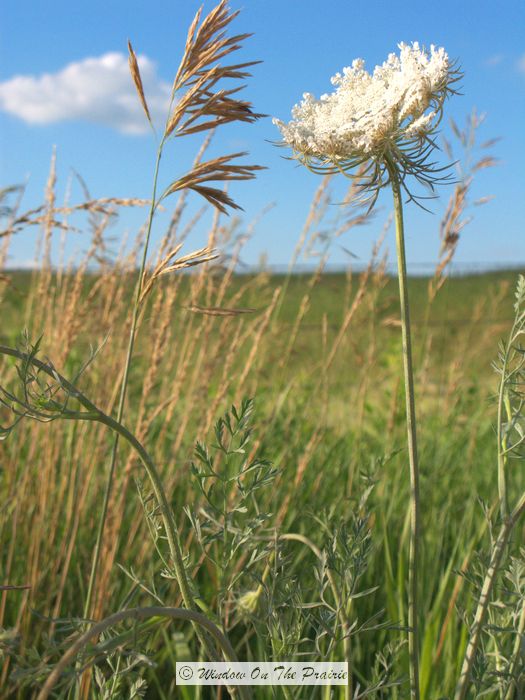
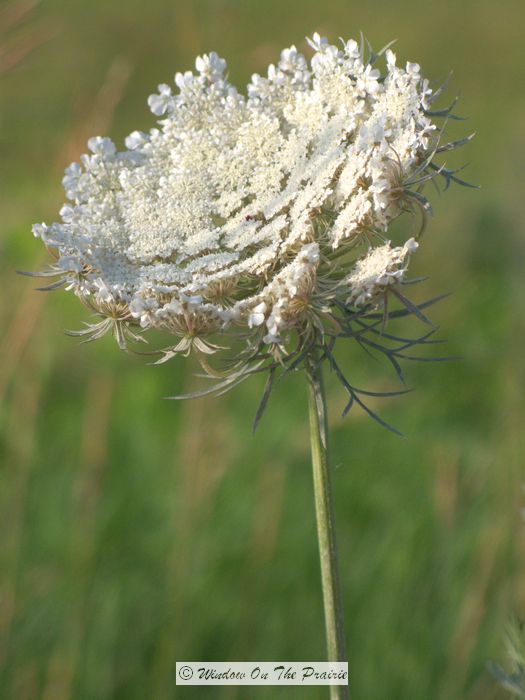
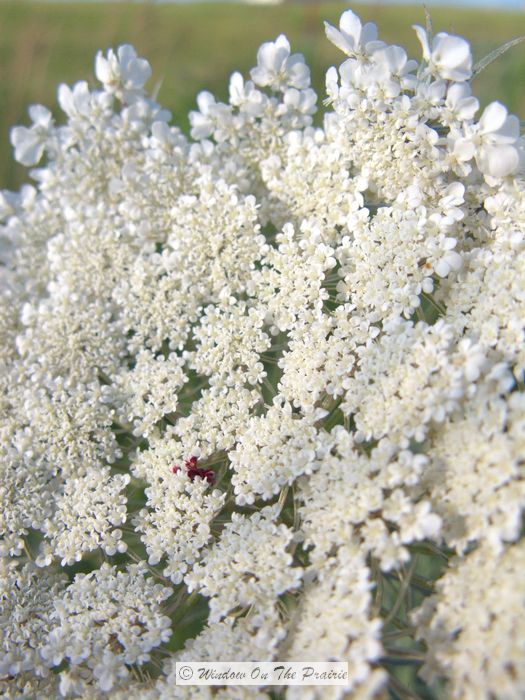
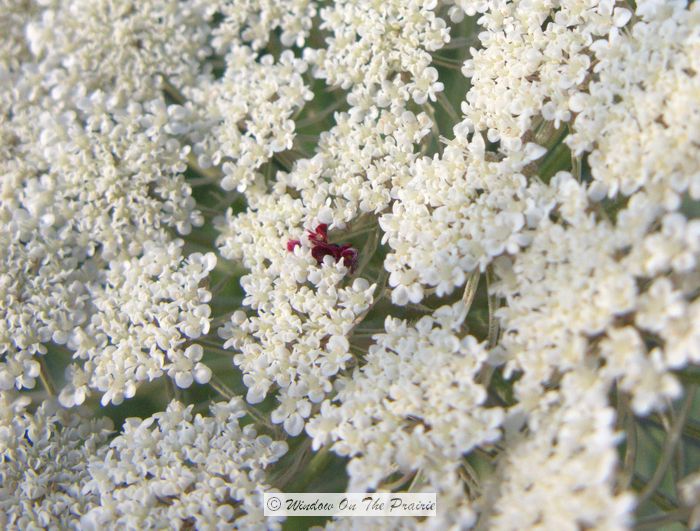
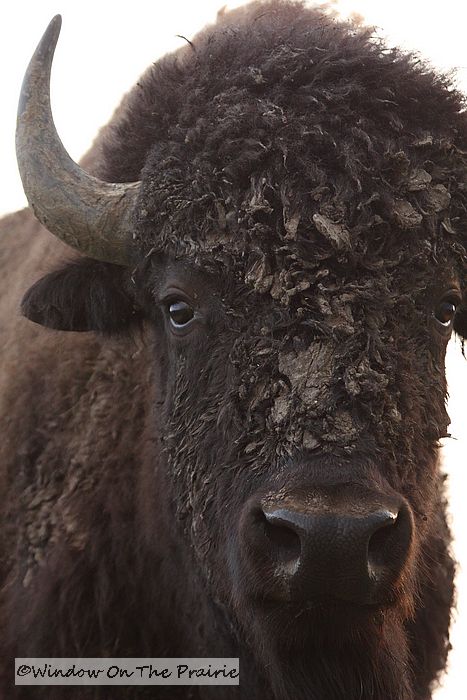
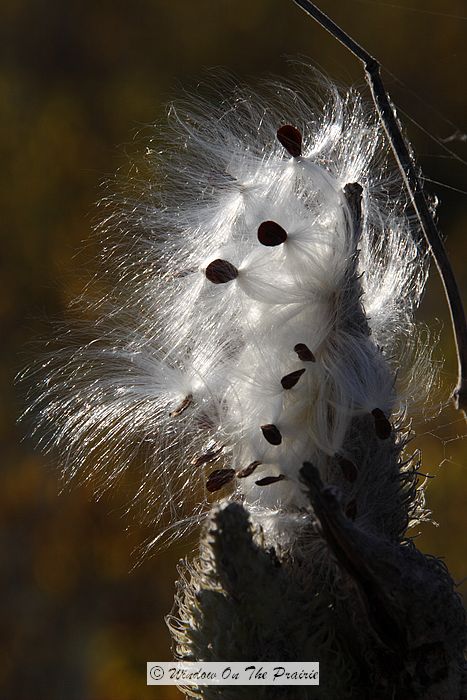
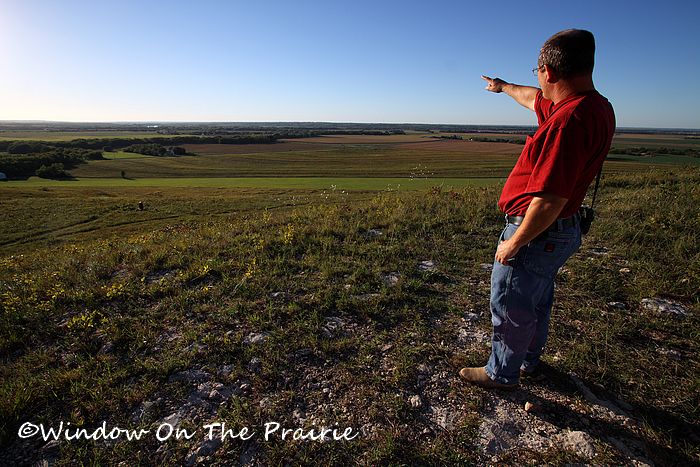
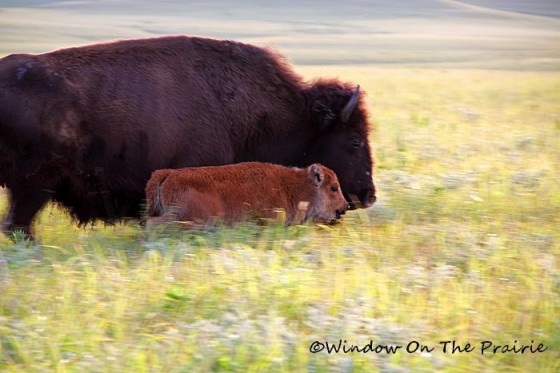
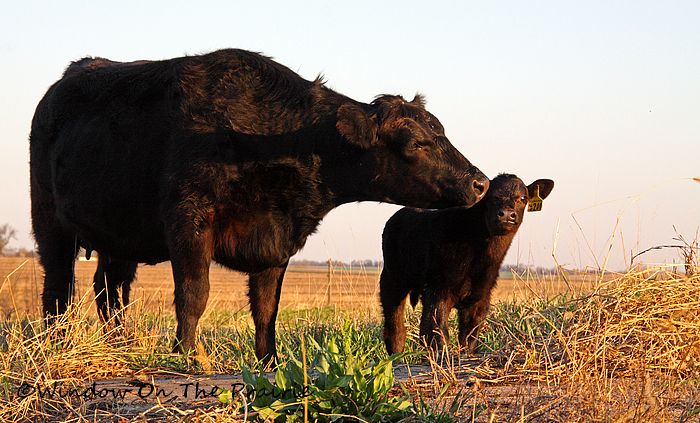

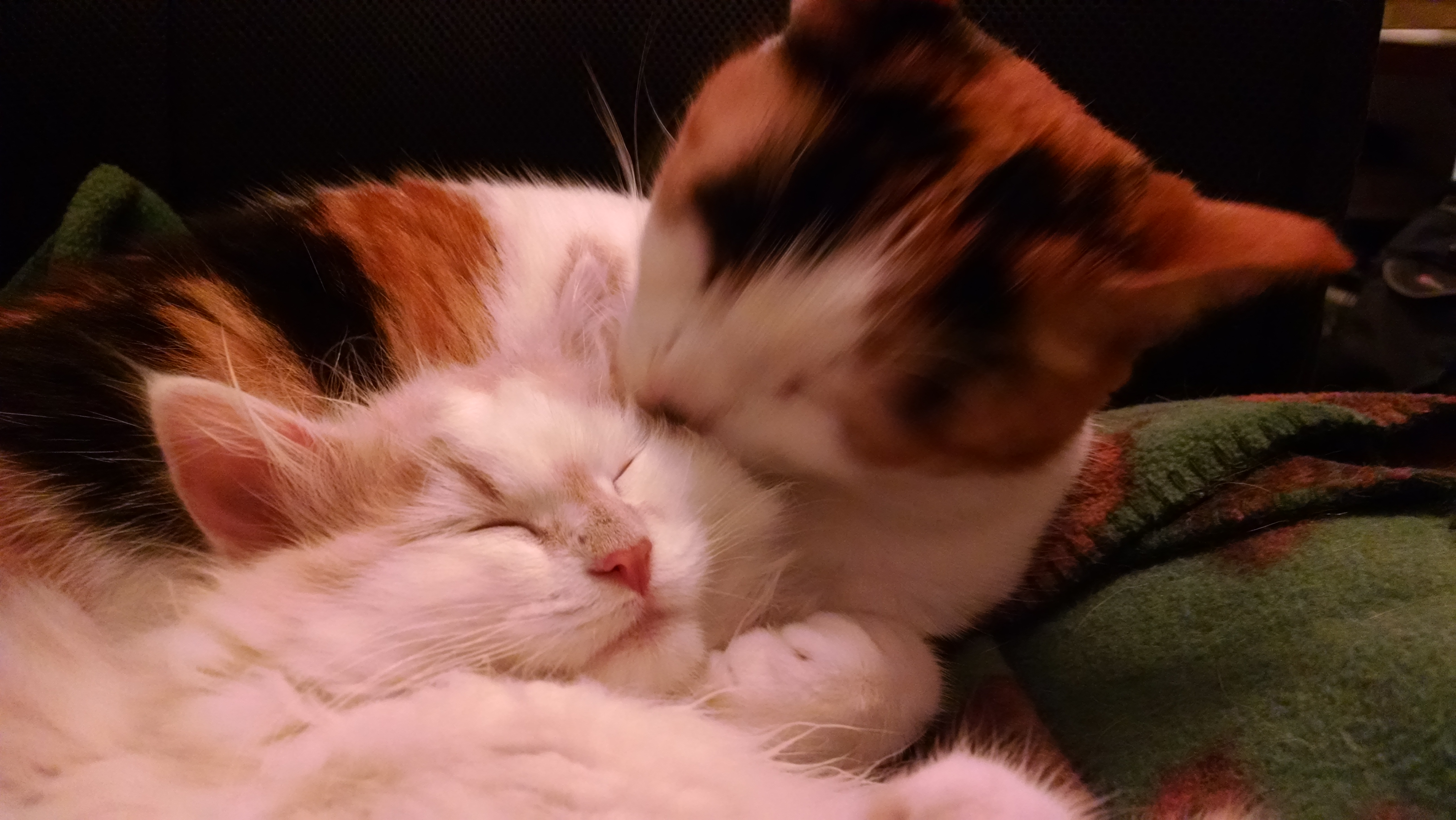
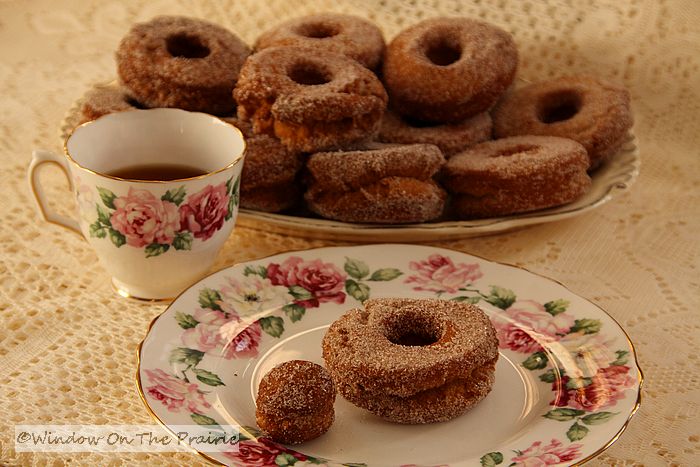




Thank you for the beautiful pictures of Queen
Anne’s Lace. I always think of Anne of Green Gables when I hear of this flower (weed?). I also thank you for the lore behind it and the beautiful close up picture of the red flower in the middle. I appreciate your observations of prairie life.
Mary,
Thank you!
These are really pretty, I’ve never heard of them before it’s sad that’s a noxious weed, those things can be a pain to deal with.
Ashlee,
I didn’t realize until recently that it is a noxious weed. 🙁
I love this plant it is one of my favorite and hang the noxious weed part. We have lots of it or a type of it here called White Curyly top and I like it also.
Linda
http://coloradofarmlife.wordpress.com
Linda,
It is a shame it’s a noxious weed -so pretty.
Yeah that sucks because it is so pretty 🙁
Ashlee,
Too true.
I NEVER knew that there was a tiny red spot in the center! I’ve always liked the Queen Anne’s Lace, but they wilt and die if you pick them and put them in a vase with other wildflowers. I guess there meant to be out in a field somewhere, blowing in the wind.
Kelly,
I had forgotten that – I used to pick them and put them in a vase- they would wilt immediately.
Suzanne,
You are an AMAZING photographer! Love your blog!!! 🙂
Hi Morningbrayfarm,
Thank you! And I so enjoy your blog also.
Suzanne
I’ve always loved the flower (have some growing by my front gate), but I had never heard the story of how it got its name. You are just a walking encyclopedia of flora.
Hi Teresa,
I love how it volunteers itself in just the right place sometimes.
Thank you!
gorgeous pictures!! You have quite a talent with your camera! Keep up the great work!
Melanie,
Thank you!
The name is so imaginative!
Hi Shailaja,
Isn’t it a fantastic name? So romantic.
The flower is really pretty! Yes really looks like lace. So gentle, pure and pretty …
Stephanie,
I love how delicate it looks.
Oh yes, Queen Anne’s Lace. I actually just took photos of these the other day. I have memories of these going all the way back to my childhood. I have always thought they were so pretty blowing in th breeze. Funny thing about the little red blossom in the middle….it always looks like a little black bug to me, and when I get really close, I realize it’s not a bug at all, but part of the flower. Thanks for the post. I love wildflowers, even if they are considered weeds to some people! Ha Ha!
Hello Bonnie,
I used to think it was a bug too, until I looked closer.
I wonder what use the colonists had for the pretty Queen Anne’s Lace. Why did they bring it from Europe? or did they bring it accidently? They brought those big Darn ol’ blackbirds too. And I’d like to send them back! lol
I love wildflowers. It is my understanding it is a wildflower unless you don’t want it . . . and then it is a weed! (unless of course your State acts and puts that wildflower on the noxious weed list.)
Hi Nance,
Thank you for stopping by! I’m not sure why the colonists brought it. Could have been accidently, but they may have brought it to have a familiar flower in their gardens. I think noxious weeds are usually plants that don’t belong in a particular area, like if they are from another country.
Suzanne
Thanks for clearing up the mystery in my carrot row. I can now say that the beautiful white flower blooming there is Queen Anne’s Lace or wild carrot!
BlonDee,
Thanks for stopping, and you’re welcome!
I love Queen Anne’s Lace. It smells heavenly! Like Bonnie, I always thought that “black” spot in the middle was a bug. It wasn’t until I started photographing it that I realized it was a tiny red flower! Just love your photos and your commentary. (I totally didn’t know about planting it close to tomatoes. Will have to try that next year.) LOVE the bokeh of the second picture. So beautiful.
Robin,
Thank you!
I love Queen Anne’s Lace too. It self seeds in my garden, but never knew there was a red flower in it before. Will have to wait till Spring time in the southern hemisphere now to check it out. I always pick it to put in with roses and our variety doesn’t wilt, just drops “confetti” as the days pass with it in the vase.
Hi Jo,
I’ll bet it looks really pretty with your roses.
Thank you!
i have picked bouquets and added food coloring to the water and what ever color i use the flower turns that color..
Hi Beth,
I’ve never heard of that. I’ll have to try it soon. Neato!
This website is not only beautiful, it’s a wonderful educational tool!
Thank you so much for your stunning photos and interesting explanations, my preschool aged son spent a long time marveling at your pictures and asking questions while I read your commentaries. Thank you, I will link you to my blog savingmomsanity.blogspot.com to let other moms know about this unbelievable resource.
Hi Linda,
I’m so glad you and your son are enjoying this. What a treat to hear from you, and than you so much!
Suzanne
I grow Queen Ann’s lace in California from North Carolina and Rhode Island seed. They each have a cobalt blue center. They come back each year, all over my yard. I love to watch them blow in the breeze as I wash the dishes or cook meals.
Hi Elizabeth,
That sounds wonderful. I like to watch them swaying in the breeze too.
Queen Anne’s Lace, Bachelor Buttons, etc. I don’t call them weeds. They are wildflowers.
Aren’t they beautiful/
Hi Monna,
Me too. I don’t call wildflowers weeds anymore.
Thank you for visiting.
Oh so pretty and so enjoy reading what you have written, yes it is a beautiful flower and in some areas it is planted but never knoew about doing it with tomatoes, interesting.
Thanks
Hi Aletha,
Thank you. I haven’t tried planting it next to tomatoes, but it’s worth a try.
I love to pick the queen annes lace and add food coloring to the water.. doesn’t take long and the colored water is absorbed into the flower and it is so pretty..
Bishop’s lace (as I grew up calling it…I think that is a more common name in Scotland) has always been my favourite flower. Sadly, I haven’t found any growing in central Texas.
I have such happy memories of my grandmother making me “crowns” of bishop’s lace. I always felt like a princess wearing my flowering tiara. I sure miss those days.
I was told that the little spot in the middle meant that it was a male plant, as it seem like some of the flowers don’t have the little flower in the center, which until I found this website, thought was black. I’m going to go right outside and examine one more closely! Thank you for all the great info!
Chantal – I’ve been wondering why some queen anne’s lace flowers have that tiny dot (flower) in the center and some don’t. Now I’m wondering if maybe you’re right; it might denote the sex. How can I find out, do you know? Thanks.